Load Regulation
| Test | 12V | 5V | 3.3V | 5VSB | DC/AC (Watts) | Efficiency | Fan Speed (RPM) | PSU Noise (dB[A]) | Temps (In/Out) | PF/AC Volts |
| 10% | 8.914A | 1.982A | 2.001A | 0.995A | 130.046 | 87.504% | 0 | <6.0 | 44.31C | 0.979 |
| 12.165V | 5.046V | 3.299V | 5.027V | 147.776 | 39.92C | 114.9V | ||||
| 20% | 18.857A | 2.974A | 3.005A | 1.195A | 260.034 | 91.865% | 0 | <6.0 | 45.55C | 0.991 |
| 12.151V | 5.045V | 3.295V | 5.022V | 283.075 | 40.84C | 114.87V | ||||
| 30% | 29.145A | 3.47A | 3.509A | 1.395A | 389.881 | 92.658% | 0 | <6.0 | 46.39C | 0.996 |
| 12.140V | 5.044V | 3.292V | 5.017V | 420.761 | 41.16C | 114.84V | ||||
| 40% | 39.449A | 3.966A | 4.014A | 1.596A | 519.813 | 92.638% | 0 | <6.0 | 47.44C | 0.997 |
| 12.132V | 5.044V | 3.289V | 5.012V | 561.074 | 41.77C | 114.8V | ||||
| 50% | 49.443A | 4.958A | 5.022A | 1.798A | 649.936 | 92.08% | 0 | <6.0 | 48.26C | 0.998 |
| 12.124V | 5.043V | 3.286V | 5.007V | 705.868 | 42.23C | 114.77V | ||||
| 60% | 59.446A | 5.952A | 6.033A | 2A | 780.053 | 91.258% | 951 | 15.7 | 42.72C | 0.998 |
| 12.116V | 5.042V | 3.283V | 5.001V | 854.706 | 49.35C | 114.73V | ||||
| 70% | 69.480A | 6.947A | 7.046A | 2.203A | 910.131 | 90.525% | 1240 | 24.4 | 43.04C | 0.998 |
| 12.105V | 5.04V | 3.279V | 4.995V | 1005.321 | 50.12C | 114.7V | ||||
| 80% | 79.533A | 7.943A | 8.06A | 2.305A | 1039.746 | 89.765% | 1558 | 30.9 | 43.80C | 0.998 |
| 12.094V | 5.037V | 3.275V | 4.991V | 1158.259 | 52.01C | 114.66V | ||||
| 90% | 90.017A | 8.444A | 8.559A | 2.407A | 1169.974 | 88.802% | 2163 | 40.5 | 44.82C | 0.997 |
| 12.081V | 5.035V | 3.271V | 4.986V | 1317.696 | 54.00C | 114.62V | ||||
| 100% | 100.241A | 8.943A | 9.09A | 3.018A | 1299.593 | 87.732% | 2315 | 42.1 | 45.23C | 0.999 |
| 12.069V | 5.034V | 3.267V | 4.971V | 1481.231 | 55.29C | 114.58V | ||||
| 110% | 110.413A | 9.941A | 10.203A | 3.019A | 1429.796 | 86.726% | 2318 | 42.1 | 46.91C | 0.998 |
| 12.059V | 5.032V | 3.263V | 4.969V | 1648.604 | 57.85C | 114.55V | ||||
| CL1 | 0.116A | 15.543A | 15.627A | 0A | 131.324 | 79.615% | 1566 | 31.1 | 39.03C | 0.899 |
| 12.164V | 5.039V | 3.302V | 5.07V | 164.559 | 44.52C | 115V | ||||
| CL2 | 0.115A | 24.78A | 0A | 0A | 126.44 | 78.038% | 1567 | 31.2 | 42.49C | 0.899 |
| 12.166V | 5.046V | 3.309V | 5.103V | 161.234 | 49.52C | 114.89V | ||||
| CL3 | 0.115A | 0A | 24.952A | 0A | 83.885 | 74.284% | 1565 | 31.1 | 41.46C | 0.934 |
| 12.157V | 5.057V | 3.306V | 5.049V | 113.088 | 50.52C | 114.93V | ||||
| CL4 | 107.666A | 0A | 0A | 0A | 1300.312 | 87.851% | 2317 | 42.1 | 47.78C | 0.999 |
| 12.077V | 5.058V | 3.277V | 5.04V | 1480.018 | 58.76C | 114.58V |
Load regulation is within 1% on all primary rails, but 3.3V, where it should be tighter.
Ripple Suppression
| Test | 12V | 5V | 3.3V | 5VSB | Pass/Fail |
| 10% Load | 10.0 mV | 7.0 mV | 7.1 mV | 5.5 mV | Pass |
| 20% Load | 9.3 mV | 9.0 mV | 7.6 mV | 7.1 mV | Pass |
| 30% Load | 11.2 mV | 6.7 mV | 7.7 mV | 3.9 mV | Pass |
| 40% Load | 12.5 mV | 6.6 mV | 7.9 mV | 5.0 mV | Pass |
| 50% Load | 13.6 mV | 6.9 mV | 9.2 mV | 5.5 mV | Pass |
| 60% Load | 14.1 mV | 7.6 mV | 9.0 mV | 5.9 mV | Pass |
| 70% Load | 16.4 mV | 7.7 mV | 10.1 mV | 6.3 mV | Pass |
| 80% Load | 17.1 mV | 9.3 mV | 11.4 mV | 8.1 mV | Pass |
| 90% Load | 18.1 mV | 10.9 mV | 13.0 mV | 8.9 mV | Pass |
| 100% Load | 23.4 mV | 12.9 mV | 12.1 mV | 11.5 mV | Pass |
| 110% Load | 25.3 mV | 14.4 mV | 13.4 mV | 12.8 mV | Pass |
| Crossload 1 | 11.4 mV | 7.1 mV | 10.4 mV | 3.8 mV | Pass |
| Crossload 2 | 9.7 mV | 6.3 mV | 7.6 mV | 3.9 mV | Pass |
| Crossload 3 | 19.9 mV | 6.2 mV | 12.8 mV | 3.3 mV | Pass |
| Crossload 4 | 22.7 mV | 10.4 mV | 11.2 mV | 8.9 mV | Pass |
Ripple suppression is good on all rails.
Pages:
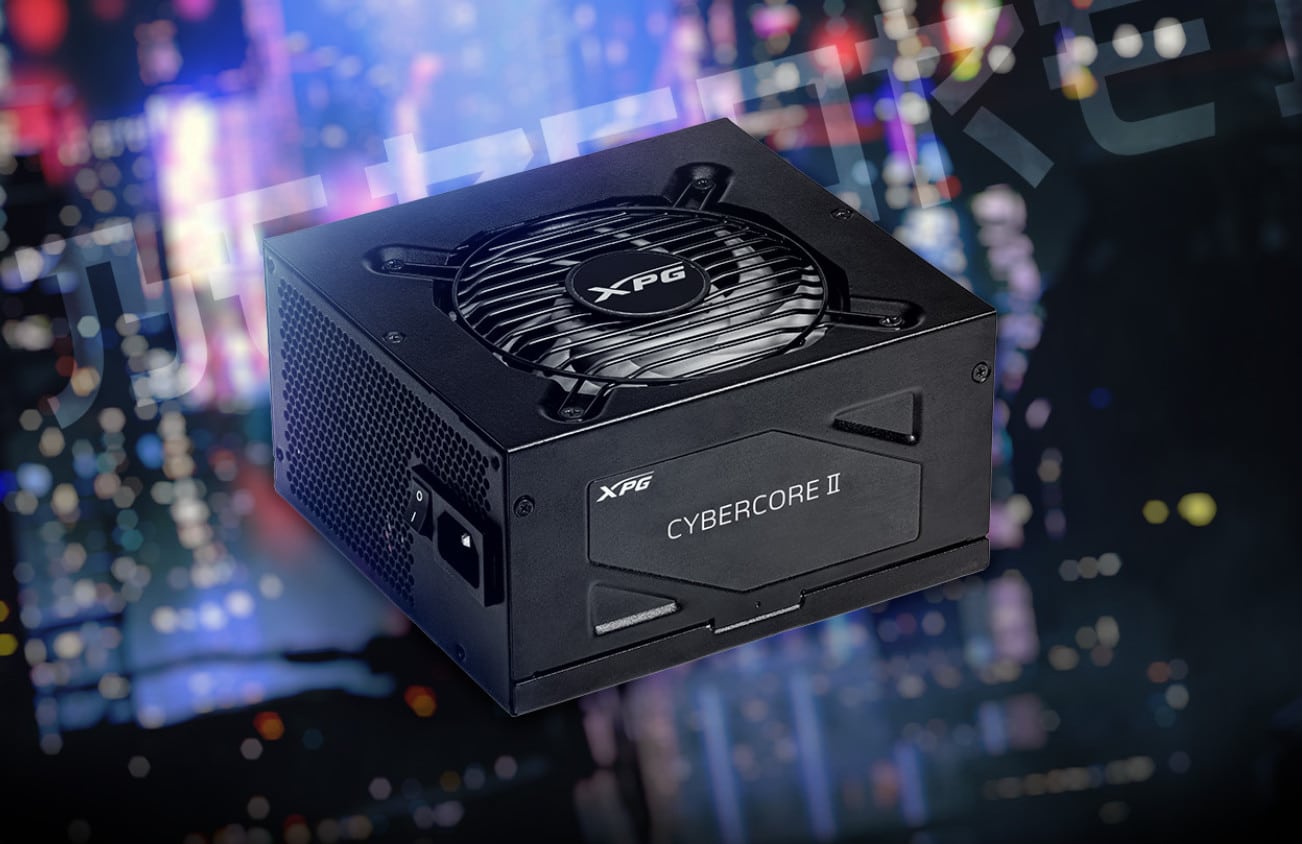
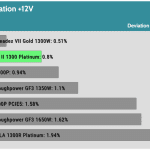
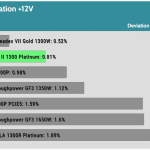
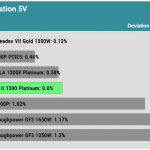
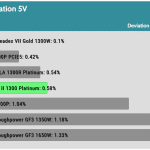
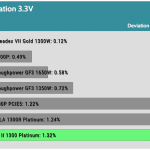
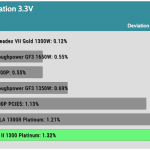
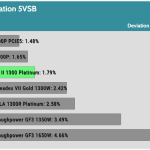
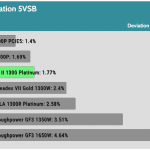
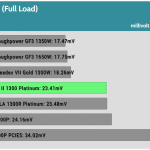
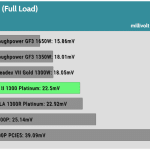

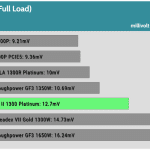
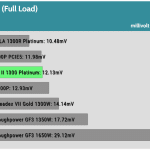
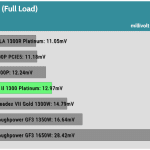
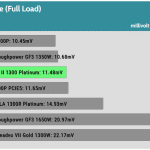



I have had the XPG Cybercore II 1300 for almost a year now.
I have tried it on two different PCs, and it works as intended with ASRock B650E PG Riptide and X870 Pro RS.
And answering the last part of your comment:
> Anyway I will forward your post to XPG to see what they will reply.
Thank you for this! I was unable to find e-mail support contact on the XPG site.
BTW, I got very strange results while checking my warranty status on the XPG and ADATA websites using the serial number:
http://www.xpg.com/en/support/xpg?tab=warranty
XPG warranty check returns me the following:
> Warranty Check
> Your product[4N14xxxxxxx] is under warranty until: 2024-10-31.
> Thank you for your inquiry.
> Your product is protected by a 1 year limited > warranty from the purchase date on your product invoice or receipt.
> Please keep your invoice/receipt for your possible future warranty claim
One (1) year limited support only (FYI, I have the EU version of the power supply, I’m not from US).
I thought the site would report me a 10Y support period or so (or at least 5Y), since on the product page, as well as in the “Support” section of the site, the seller states a 10-year warranty on PSU of this series.
Just wondering what caused the support period to be reduced by 10 times?
I’m a bit confused about this.
PS: In theory, this discussion could be toxic for the vendor XPG / ADATA.
If toxic comments like this from users who are “extremely dissatisfied with the quality of the product purchased” are not welcome on this site, please tell me and I will leave (but please do not delete the entire discussion above).
sorry but I am very skeptical that this guy has a 6.5 dBA chamber to test PSUs. I also couldn’t find any data for his instrument, and also there are no frequency plots for the noise he mentions. Moreover, he measures too close to the PSU, the ISO standard is 1 meter away.
12 dBA noise is too low to notice! Also 12 dBA noise at 35 cm are WAY lower at 1 meter! And you will usually have the PC case even further away. All in all to be frank I don’t trust anyone’s measurements, unless he has an ISO 17025.
Back to the topic, this is a standard CWT platform. Some changes in parts can cause a problem but this is not because they are of low quality. Nobody wants to follow this road.
Anyway I will forward your post to XPG to see what they will reply.
People were also complained HUGE time about the Vertex PSUs. I have several installed on my test machines. IF I hear any coil whine is from the GPUs I test and not the PSU. GPUs make hell more coil whine than PSUs.
Thank you for your response.
But I see that some points were not very clearly stated or translated by me in previous posts.
> “sorry but I am very skeptical that this guy has a 6.5 dBA chamber to test PSUs.”
As I noted above and as they noted in their reviews (please use Google Translate),
noise levels are given as a delta from the ambient noise (the difference from the background noise level).
> “Also 12 dBA noise at 35 cm are WAY lower at 1 meter! And you will usually have the PC case even further away.”
Their methodology is obviously more rigorous than yours, which is ISO based and involves measuring noise levels from a distance of 1 meter.
For those who did not bother to follow the links above, for a better understanding of the context, here is a partial description of their methodology for testing consumer power supplies:
> “The power supply is located on a flat surface with the fan facing up; above it, at a distance of 0.35 meters,
> the measuring microphone of the Oktava 110A-Eco sound level meter is placed, which measures the noise level.
>> This distance to the measurement object is the closest for a desktop placement of a system unit with an installed power supply. < This method allows you to evaluate the noise level of a power supply in harsh conditions
> from the point of view of a short distance from the noise source to the user.”
But let’s be honest with ourselves.
Both you and the guys from that site are testing _consumer_ devices designed to be placed not somewhere in closed server racks nor in some kind of industrial or commercial equipment.
You are testing devices designed to be placed in personal computers, including desktop computers, which are often located at a short distance from the user.
Therefore, strictly adhering solely to industry standards in evaluating personal desktop devices will not allow the review to reflect real-world consumer experience.
That’s why I fully agree with their approach in measuring desktop PC noise levels:
> “This distance to the measurement object (0.35m) is the closest for a desktop placement of a system unit with an installed power supply.”
The thing is that I have a desktop PC.
My PC is located directly on the table – not on the floor at a some distance nor in another room 😉
You might be surprised, but many users place their computers on their desks just like I do.
That is why the measurement results from that third-party site seems to me more reliable and closer to real life.
Moreover, my own experience of using this device confirms their measurement results.
Regarding the second part of your answer:
> Back to the topic, this is a standard CWT platform.
> Some changes in parts can cause a problem but this is not because they are of low quality. Nobody wants to follow this road.
All the information I got during the discussion led me to the assumption that the CWT-CTT platform used in my units and the units reviewed here has some kind of inherent design defect leading to the constant presence of high-frequency noise at low load levels (below 50- 60 W).
But it looks like I was wrong about that!
After some additional digging on that third party site (ixbt), I found a review of another CWT-CTT based device that can also be used for comparison.
They reviewed the DeepCool PX1300P 1300W, which is almost identical to the CYBERCORE II 1300W.
http://www.ixbt.com/supply/deepcool-px1300p-review.html
According to Cybenetics reports, the most noticeable difference between the units for the end-user will be the use of a slightly lower quality fan with high starting RPMs and high noise levels due to a suboptimal fan rotation curve.
You’ll be laughing, but the PX1300P showed no high-frequency electronic noise at low load levels!
According to acoustic measurements using the same methodology they used when evaluating other PSU units:
> Power. Noise level from the grille side. Deviation from background level.
> 50 W 22,7 dBA 2,7 dBA
Also they have commented the gathered results with the following note:
> “The electronic noise here is minimal;”
> “It will be almost impossible to hear it even from a minimum distance, not to mention the assembled system.”
Reading this made me want to shout (because I couldn’t attach the famous picture to the post):
” 2.7dB, Karl !!! ” 😉
Please do not treat my little investigation as an advertisement.
I know absolutely nothing about this brand DeepCool and have no idea about their quality and duration of support.
The only thing I wanna say is that using the same base platform both high-quality devices and completely low-quality ones can be produced.
I have no idea what the real difference between these devices is, it could be quality components or having minimal quality control, etc.
And I have no idea who’s responsible for this – ODM or the Brand itself.
PS:
> IF I hear any coil whine is from the GPUs I test and not the PSU. GPUs make hell more coil whine than PSUs.
Unfortunately the issue with my unit occurs _before_ installing of a GPU, right after I finished with the platform itself and started initial software installation, tuning and testing.
sorry, but while 12dbA might be too low for you, its not for everyone.
i have tinnitus and try to avoid “noise” as much as i can, and have multiple 8dbA case fans that i have to throttle down to less than a third of the rpm, just so they become inaudible, with the case 2ft away on the desk.
and i dont like fan off/semi-passive mode, as it draws in “unfiltered” air, so with the psu fan always running, it needs to be below 8-10 dbA for me to not become annoying.
@George
the US shop lists the following:
8 industrial protections, backed up by a 10-year warranty.
many brands refuse to offer warranty that goes past the period required by law, and usually only offer longer if purchased from them directly.
ignoring that EU law says 2/3y warranty, but might be thru the seller, not mfg.
@Zoson
just because it didnt work for you, doesnt mean there is an issue.
unless you have the same problem on +2000 units, its not even statistically relevant, and i have seen multiple times where one psu wont work with hw on one pc, but in another one with “same” type of hw (but different brands) without trouble.
when i wanted to upgrade to +700w, i had to try 3 different units before i got one that was not giving me BSOD’s under load, while they are still working in the computers i installed them later.
with millions of possible components, its impossible to guarantee something will work with eveyrthing.
Hi!
I bought my XPG Cybercore II 1000W no more than three months ago.
The 1000W model I bought is almost identical to the one observed here (2 extra MOSFETs as I can see from Cybenetics report).
The most disappointing thing I encountered was the constant presence of a nasty high-frequency noise (squeaking or whistling) under low loads.
This nasty noise/squeak appears only under light loads (web surfing, working with office documents, etc.) and disappears under any heavy load (gaming, video conversion, etc).
Irritation and discomfort are caused not by the presence of this sound as such, but because of its high frequency.
The sound is near the limit of audibility, somewhat reminiscent of a mosquito squeak, but constantly changing in frequency and intensity, regardless of the load on the system.
.
This noise is somewhat similar to the whistling of inductors, which can sometimes be found in ultra-budget power supplies.
I was very disappointed to find such a stupid defect in a power supply that costs me about $200
.
Therefore, I have a question to the author.
Could you please to confirm or deny the presence of such type of noise in the observed unit (1300W model) under light loads?
As I can see in the noise graph, in Passive mode there is a sawtooth noise fluctuation.
Could this be a sign that the 1300W model has the same issue as my 1000W unit?
.
Thank you in advance.
.
PS: I’m currently in the process of RMA because the official distributor refused to replace the device or refund the money.
I’m considering the 1300 W model as a replacement, but I’m afraid of getting a defective device made from low-quality components again.
Coil whine, the problem you face, mostly has to do with the combination of hardware. It can also be from the GPU, in combination with this specific power supply. Moreover, most modern PSUs have this problem at light loads because of Intel’s 2% efficiency requirement, which forces the PSUs to operate at burst mode under light loads. The LLC resonant circuit can also create issues, but I suspect that the main culprit is the burst mode operation, which most PSUs have nowadays. Now I heard stories that some brands tell the OEMs to remove it in the final production units, with which I don’t agree of course.
> “Coil whine, the problem you face, mostly has to do with the combination of hardware.”
Unfortunately, this is not my case.
There are not so many real reviews and end-user opinions about the CYBERCORE II product line I was able to find on the Internet.
After a lot of Googling, I managed to find two interesting reviews on the website ixbt.com (in Russian, use Google Translate).
http://www.ixbt.com/supply/xpg-cybercore-1000-platinum-review.html#n11
http://www.ixbt.com/supply/xpg-cybercore-ii-1000-platinum-review.html#n11
The older review describes the CYBERCORE 1000W model (1st generation without 12VHPWR port), and the newer review describes the CYBERCORE II 1000W (2nd generation).
Both models are based on the same CWT-CTT platform and made of almost the same electronic components, so they can be directly compared (with some limitations).
Comparing these reviews, I found something interesting in the Acoustic Ergonomics section:
1. For CYBERCORE (1st generation) they measured the following noise levels (with the cooler stopped):
> “In general, electronic noise can be considered relatively low: the excess of background noise was no more than 6.5 dBA.”
2. But when measuring CYBERCORE II (2nd generation), an abnormal noise level of 12 dBA was detected from the electronics in passive mode with the cooler stopped:
> “When operating at a power of 50 W, an atypically high noise from the electronics was noticed;”
> “It even affected the noise of the power supply as a whole, since the fan did not rotate in this mode.”
> Power – 50 W
> Noise level from the grille side – 32 dBA
> Deviation from background level – 12.0 dBA (delta from ambient noise)
They also provided the following explanation regarding the noise level assessment:
> “If the obtained value is within 5 dBA, there are no deviations in the acoustic properties of the power supply.”
> “With a difference of more than 10 dBA, as a rule, there are certain defects that can be heard from a distance of about half a meter.”
As far as I can tell, they describe the same issue that I had the pleasure of seeing on my device.
It looks like the problem is neither related to the specific hardware used (they are using some kind of artificial load during their tests) nor to the burst operation mode.
Rather, it seems that defective or low-quality components were used during production.
P.S.: I just remembered that a similar situation happened six months ago with ENERMAX, which was forced to completely recall the REVOLUTION series of power supplies because of low quality and a huge amount of RMAs;))). The shortage of electronic components has been a thing of the past for a couple of years now, but electronics continue to be assembled from defective parts just like then.
Did XPG tell you when this variant will actually be available? Right now it seems they’re trying to clear stock of the v1 cybercore 1300, and the v2 is vaporware/nowhere to be found.
They told me that they would have stock soon, but didn’t define any dates.
FYI there appears to be a serious issue with these power supplies. I have now had two of them(RMA’d the first) and neither was able to power my ASUS WS PRO W790 ACE with Xeon 2455x. The board literally will not post with the Cybercore II 1300W, it gets stuck at 00, before cpu initialization! Meanwhile my ancient 11 year old Seasonic X1250 has no problems with this same system.
ADATA/XPG RMA is also not accessible, it’s literally impossible to submit an RMA, as their form tells you to fill in required values, even when everything is fully filled in. Additionally, I emailed the support mail it says to contact if the form doesn’t work, and it’s been over a week with no reply.
I bought this power supply on the high recommendation of this review, so it seems appropriate I post this warning here.
I will report this to XPG ASAP!
Hi, I was wondering: Why does the transient response chart not include all the power supplies that were subjected to this test? For example, the Dark Power 13 1000W got 11.45V in this test. Is it because it targets 1000W while the listed power supplies target 1300W or above? Or did something change in the testing procedure?
I try to keep in the lists/charts similar capacity PSUs.